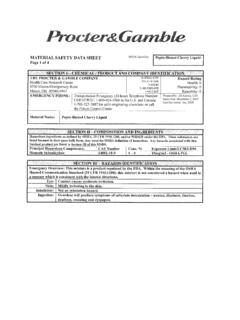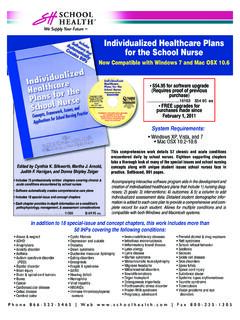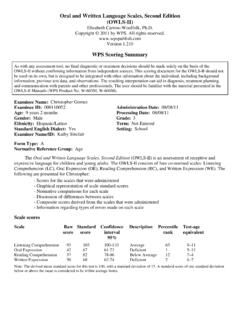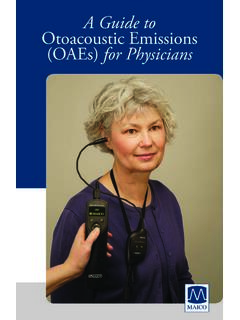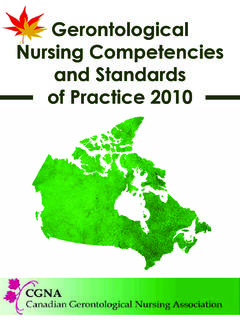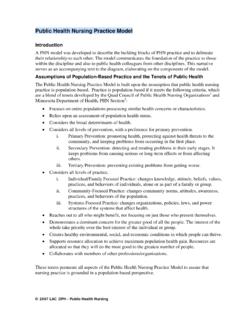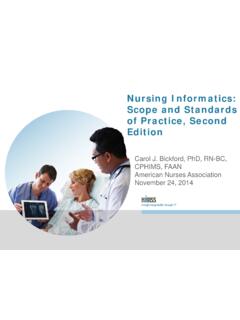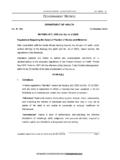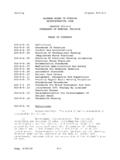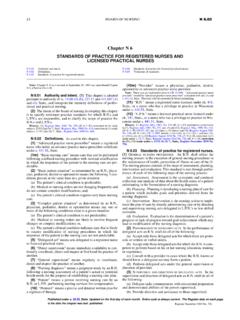Transcription of LEADERSHIP AND MANAGEMENT - School Health
1 XXI School Nurse AdministratorsLEADERSHIP AND MANAGEMENT Section I Foundation for LEADERSHIP and Management1. Using Scope of Practice and standards as a Framework for nursing Administration in Schools Susan G. Praeger 52. Applying Conceptual Models and Theories in the Administration of School nursing PracticeLaura Jannone 313. Expanding LEADERSHIP Skills with TheoryMarie C. DeSisto, Nicole Pennington 57 Section II Partnerships, Collaboration, and Resources4. Collaborating With School District Partners: Challenges and OpportunitiesCynthia K. Silkworth, Ann Hoxie 815. Sharing a Common Vision: School and Community CollaborationsVictoria J.
2 Ladd 1096. Advocating for Partnerships and Collaborations at the State LevelWendy Doremus 1337. Finding Answers Using Online Information ResourcesJanene Batten, Linda Caldart-Olson 151 XXIIS ection III Staffing and Personnel Issues8. Staffing School Health Services for Effectiveness Jean Grabeel, Patricia Shull 1779. Securing and Preserving a Strong School nursing Workforce Freddi Adelson, Cynthia Greenberg 19910. Managing School Nurse Performance for Success Deborah C. Somerville 231 Section IV Professional Development11. Engaging and Empowering New Staff Janis Hootman 25712.
3 Promoting and Producing Quality Continuing Professional Development Janis Hootman 291 Section V School Health Business Practices13. Establishing Policies and Procedures: The Core of School nursing Practice Patricia Krin, Vicki Taliaferro 339 14. Transforming School Health Data into Information and Knowledge Martha Dewey Bergren, Lynn Choromanski, Brenda C. Isaac 365 15. Maximizing Financial Resources for School Health XXIII Mary Ann Delleney, Deborah Bettencourt 39916. Navigating the Reimbursement Maze to Fund School nursing Services Janet Lowe 433 17. Understanding the Legal Landscape Michelle C. Laubin, Nadine C. Schwab, Janice Doyle 459 Section VI Program Advancement18.
4 Using Evidence-Based Practice to Manage and Advance School NursingProgramsMarie Foley 52119. Evaluating School Health Programs Mary Jo Baisch, M. Kathleen Murphy 547 20. Promoting the Value and Image of School NursingVickie H. Southall 575 Index 605 Appendix CD5 Chapter 1 USING SCOPE OF PRACTICE AND standards AS A FRAMEWORK FOR nursing ADMINISTRATION IN SCHOOLSS usan G. PraegerChapter OutlineIntroductionScope of nursing AdministrationStandards of nursing AdministrationRegulatory StandardsStandards of Educational Leaders in School SettingsFuture ConsiderationsConclusionAPPENDIXI ntroductionSchool nurses are accountable for functioning within the scope of nursing practice as defined by state regulating bodies and within the scope of School nursing as defined by the professional organization.
5 They are also accountable for meeting the standards of School nursing practice. These standards are accessible in a joint publication of the American Nurses Association (ANA) and the National Association of School Nurses (NASN): School nursing : Scope & standards of Practice (ANA/NASN, 2011). However, the LEADERSHIP and MANAGEMENT of School nursing in educational settings require more than meeting the standards of being a School nurse. Recognition of the vital role in administering Health services or nursing programs in schools carries the added responsibility of the nurse in the role of administrator. Consequently, School nurse administrators need to consider the scope of the role of administrator as well as the scope of the role of School nurse when planning, implementing, and evaluating their position. The standards to which they are held accountable also include the standards expected of all nurse administrators with consideration for the specialty practice. The purpose of this chapter is to examine the unique role expectations for School nurse administrators based on professional standards , regulatory standards , and LEADERSHIP standards in ANA (2010a) has advanced the practice of nursing by overseeing the publication of the scope and standards of nursing for all professional nurses.
6 In addition, the ANA has helped to promulgate, publish, and promote a description of the scope of most nursing specialty areas and their specific standards (ANA, 2010b). The process involved in promulgating these standards includes a thorough, deliberate, and time-consuming discussion among individuals who practice in the specialty area representing the specialists in the field. Feedback from specialists is invited, revisions are made, and consensus is sought so that the entire specialty of the profession is able to clearly and agreeably state what can be expected of individuals practicing in the nursing specialty. scope and standards documents clarify that standards are authoritative statements that come from the professions themselves. This differs from a document that summarizes the laws, rules, or regulations that are promulgated by legislative bodies, which would have had input from the profession but were not exclusively written by the profession. Professional nursing standards inform the public of what can be expected of individuals in the specialty.
7 One can think of them as the minimum expectations for practice. standards influence laws, rules, regulations, job descriptions, educational programs, and criteria for professional evaluation, and they serve as criteria for determining accountability in legal decisions (ANA, 2010a, 2010b).Scope of nursing Administration In 2004 2005 the NASN charged a task force with exploring the development of standards for School nurse administrators. The consensus of the task force was that separate standards for School nurse administrators were not needed. Subsequently, the ANA published the revised text titled nursing Administration: Scope & standards of Practice (ANA, 2009), describing the scope of nursing administration and the standards that are expected of nursing administrators employed in all nursing specialties in a variety of settings. School nurse administrators who practice within the context of the educational system are accountable to these 2009 ANA nursing administration standards as well as the School nursing chapter includes a review of ANA s scope and standards of nursing administration as a framework for understanding and defining LEADERSHIP and MANAGEMENT theories and practices in schools, the resources unique to the role, staffing and personnel issues, and professional development roles.
8 Unique School Health business practices often regulated by federal, 7state, and local educational laws and the role of LEADERSHIP in the School setting and in the School nursing profession are described later in this ANA nursing administration text (2009) follows a presentation similar to the scope and standards of other specialties, including School nursing : Scope & standards of Practice (ANA/NASN, 2011) and is similar to the format published in ANA s nursing : Scope & standards (2010a) addressing nursing practice in all settings. Starting with a description of the scope, the standards of practice (assessment; identification of issues, problems, or trends; outcomes identification; planning; implementation; and evaluation) and the standards of professional performance (quality of practice, education, professional practice evaluation, collegiality, collaboration, ethics, research, resource utilization, LEADERSHIP , and advocacy) are then described. The scope and standards of School nursing and nursing administration are basically similar in structure, although the content indicating expectations and competencies is unique and specific to the role of leader in the School Health arena (versus the role of a Health care provider of a School nurse).
9 Structural differences between the standards of nursing administration and School nursing practice are evident between the two documents. For instance, School nurses are expected to diagnose relevant problems, whereas the nurse administrator analyzes the assessment data to determine issues, problems or trends (ANA, 2009, p. 26). According to the ANA, administrators are representatives of their profession and advocates for nursing and Health care systems that provide excellence in care and improve Health , patient safety, and quality while using creativity, LEADERSHIP skills and strategies to support others (ANA, 2009, p. 2). The School nurse administrator represents School nurses and advocates for School Health services focusing on students and their families, staff, schools, and administrators are important to organizations because they are charged with dealing with issues at all levels of an organization: consumers (students and their families, staff, programs, School , community), Health care delivery, staff organization, district policy, employee relations, resource acquisition and utilization, and staff development.
10 Nurse administrators help define the values of the ; foster collaboration, communication, and goal-setting; and strive for excellence among and across the continuum of care and the populations they work with or affect (ANA, 2009, p. 4). It is clear from this statement that School nurse administrators not only should directly supervise School nurses but also need to interact with all facets of the School system in order to be success is often measured through external evaluations. Employee satisfaction, successful recruitment and retention efforts, quality outcomes, and elevation of the image of nursing practice are metrics often used to determine the success of the nurse administrator (ANA, 2009, p. 5). In the School environment, being able to demonstrate the value of School Health services in relation to the educational achievement of students is essential and could be a key performance evaluation administrators need to be well prepared and project a shared vision for the future (ANA, 2009, p.)

